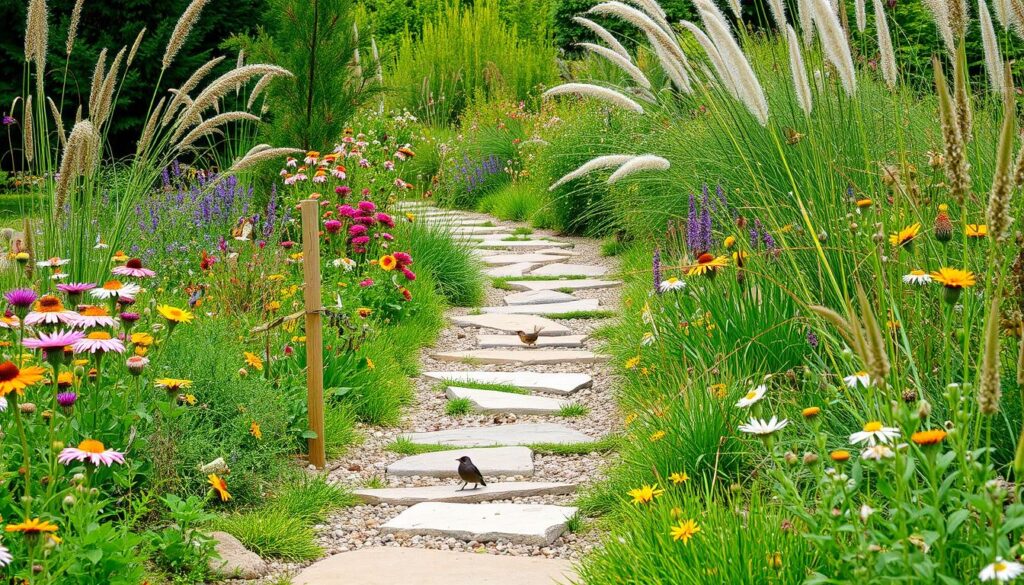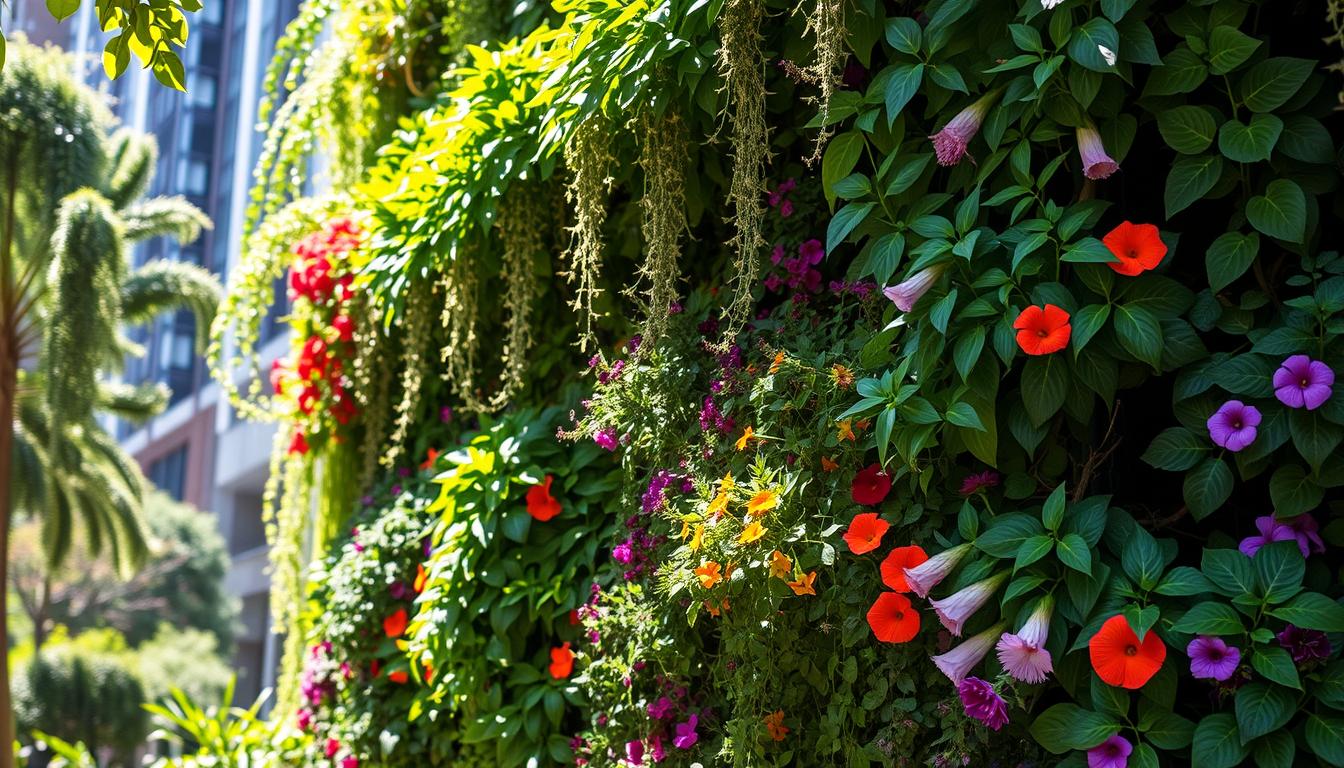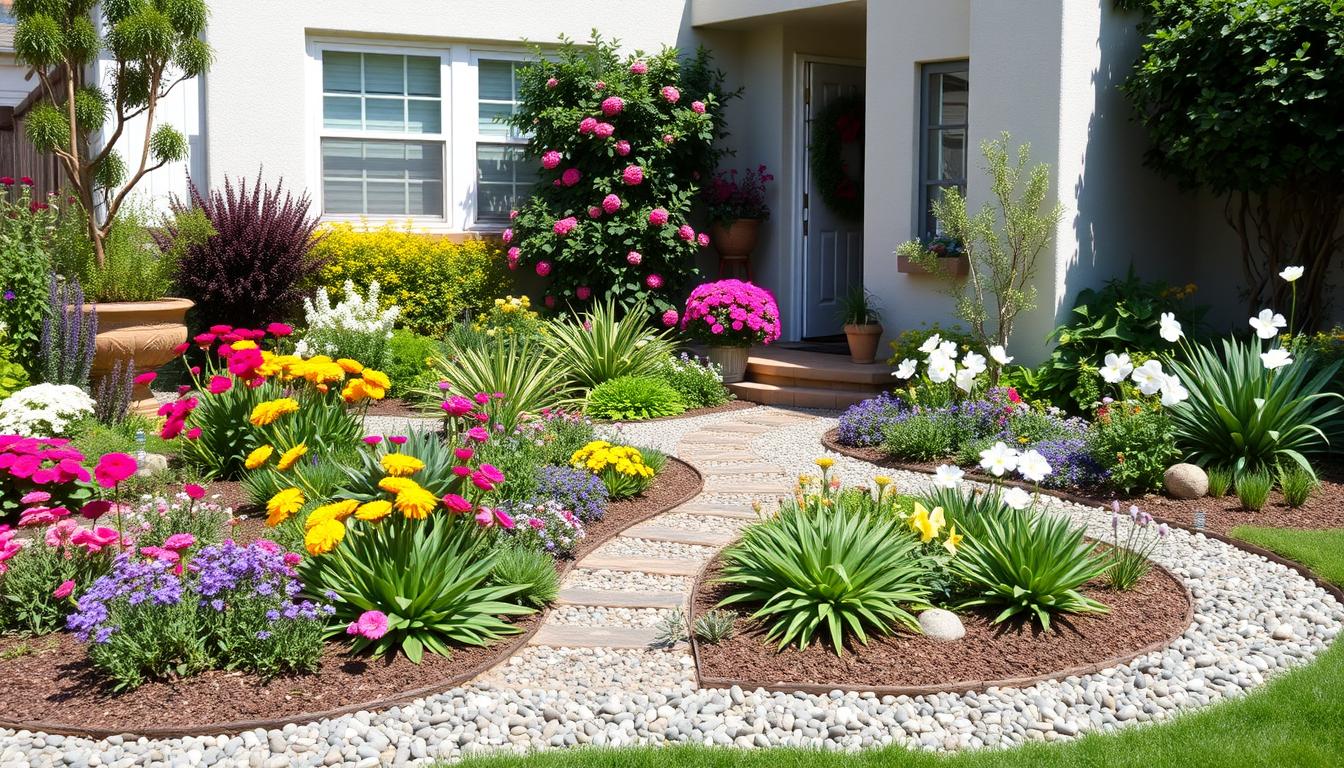“The true secret of happiness lies in taking a genuine interest in all the details of daily life.” – William Morris, renowned English designer and writer. This timeless wisdom perfectly encapsulates the essence of cultivating a captivating garden landscape. At the heart of this transformation lie the pathways that guide our steps and define the flow of our outdoor oasis.
Crafting a mesmerizing garden experience starts with the thoughtful design of its pathways. These winding trails serve as the canvas upon which we paint our horticultural masterpiece, seamlessly blending form and function to create a harmonious and visually captivating environment. Whether you’re seeking to revitalize a tired landscape or breathe new life into a cherished outdoor space, exploring the realm of creative pathway ideas can elevate your garden’s look and usher in a new era of enchantment.

Key Takeaways
- Discover innovative ways to transform your garden with creative pathway designs
- Understand the importance of pathway flow and layout in enhancing the overall aesthetic
- Explore a range of natural stone and paver solutions for stunning pathway installations
- Embrace sustainable and eco-friendly path materials to create a greener, more harmonious landscape
- Elevate your garden’s ambiance with strategic lighting and decorative elements along the pathways
Creative Pathway Ideas to Elevate Your Garden’s Look
Creating beautiful garden pathways can change how your outdoor spaces look. From new design trends to key planning elements, there’s a lot to learn. It’s exciting for homeowners and garden lovers.
Modern Design Trends for Garden Pathways
Garden pathways are now more than just straight lines. Curved and stepping stone paths are becoming popular. They follow the natural shape of the land, adding mystery and inviting exploration.
Understanding Path Flow and Layout Principles
The way pathways flow and are laid out is key. They should lead visitors to interesting spots like seating areas or water features. Good path design makes the garden look better and easier to enjoy.
Essential Elements of Pathway Design
- Material selection: You can use many materials, like stone or pavers, each with its own look and feel.
- Width and proportion: The path’s width should be right for walking and looking good. It should fit well with the garden’s size.
- Integration with the landscape: The best paths blend with the garden, matching the plants and land shape.
By looking into these trends and principles, you can make your garden paths more beautiful and useful. This will make your outdoor space more inviting and fun.
Natural Stone and Paver Pathway Solutions
Creating stunning garden pathways is easy with natural stone and pavers. These ideas can make your outdoor space look great and last long.
Natural stone walkways, like flagstone, slate, or limestone, add timeless beauty. They show off nature’s beauty and are safe to walk on. Pavers let you pick from many shapes, colors, and patterns, including brick and stone.
Choosing the right material and installing it well is key. Knowing how to lay out paths ensures they look good and last. This helps guide your garden’s design.
Exploring Natural Stone Options
Natural stone offers many choices for your paths, each with its own charm:
- Flagstone: Known for its natural look and earthy colors, flagstone gives a rustic feel.
- Slate: Its smooth look makes slate pathways sleek and modern.
- Limestone: Strong and versatile, limestone adds a classic elegance to gardens.
Paver Pathway Designs
Pavers let you design paths that match your style:
- Brick pathways: They offer a warm, welcoming feel to outdoor spaces.
- Interlocking pavers: With many shapes, colors, and patterns, they’re perfect for modern designs.
- Permeable pavers: They’re good for the environment and keep your paths looking nice.

Whether you pick natural stone or pavers, these ideas can make your garden look better. They also make your outdoor spaces durable and functional.
Sustainable and Eco-Friendly Path Materials
In the world of eco-friendly landscaping, garden path materials are key. Homeowners and designers are looking for ways to make outdoor spaces beautiful and green. They want to reduce harm to the environment.
Recycled Material Options
Using recycled materials for paths is a smart choice. Gravel paths from recycled concrete or glass are durable and save money. They also keep waste out of landfills. Mulch pathways from recycled wood or bark are natural and let water soak in, keeping the soil moist.
Water-Permeable Pathway Choices
Water management is crucial in sustainable gardens. Water-permeable pathways like porous pavers help rainwater soak into the ground. This reduces flooding and supports the ecosystem.
Native Plant Integration Along Paths
Adding native plants to path edges is a popular trend. These plants need less care, water, and chemicals. They make paths look good and help local wildlife, boosting the area’s biodiversity.

“Sustainable gardening is not just about the plants we choose, but also the way we design and maintain our outdoor spaces. Eco-friendly pathways are an essential component of creating a truly sustainable landscape.”
Lighting and Decorative Elements for Garden Paths
Make your garden paths more inviting with the right lighting and decor. Pathway lighting can change your outdoor space, making it safer and more welcoming. Choose from soft path markers to bright spotlights to highlight your garden’s beauty.
Add a personal touch with whimsical garden path decor. Unique stepping stones and decorative borders can make your path stand out. Use materials like natural stone or recycled items to make your path truly unique.
Lighting and decor can improve your garden paths in many ways. They can make your garden safer, more beautiful, or just more fun. Try different styles to find the perfect mix of beauty and function, creating a beautiful outdoor space.
FAQ
What are some creative pathway ideas to elevate my garden’s look?
There are many ways to make your garden’s pathways stand out. You can try curved paths, stepping stone paths, or use natural materials like stone or gravel. Adding lights and decorative stones can also make your garden more interesting.
What are the latest modern design trends for garden pathways?
Modern garden pathways often feature clean lines and geometric shapes. Natural stone or pavers are popular choices. Using materials like gravel or decomposed granite helps with water flow. Curved paths and native plants along the edges add a natural touch.
How can I ensure proper path flow and layout in my garden design?
Design your garden paths to guide visitors smoothly. Place key features thoughtfully and connect different areas well. Consider the path’s width, curves, and how it frames the view. This makes your paths easy to follow and beautiful.
What are the essential elements to consider when designing garden pathways?
When designing pathways, think about the materials, path width, and how they fit with the landscape. Choose durable, easy-to-care-for materials that match your garden’s style. Ensure the paths are wide enough for easy walking and blend well with the landscape.
What are some eco-friendly and sustainable pathway material options?
For green pathways, use recycled materials like reclaimed brick or stone. Permeable options like gravel or mulch are also good. Adding native plants and using porous pavers can help with water flow and support local wildlife.
How can I incorporate lighting and decorative elements to enhance my garden pathways?
Lighting can highlight your pathways, making them safer and more inviting. Use path lights or solar-powered options for a soft glow. Decorative stones, borders, or whimsical accents can add personality to your paths.




